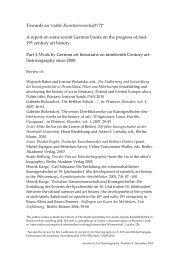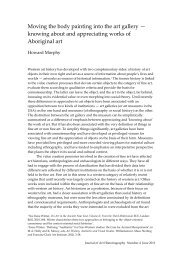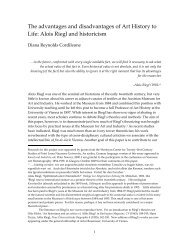7-BS/1 - Journal of Art Historiography
7-BS/1 - Journal of Art Historiography
7-BS/1 - Journal of Art Historiography
Create successful ePaper yourself
Turn your PDF publications into a flip-book with our unique Google optimized e-Paper software.
Barbara Stoltz Disegno versus Disegno stampato: …<br />
besides those that have been mentioned, there may be seen something <strong>of</strong> the<br />
good (...). (194 – 195) 42<br />
The citation gives us an idea <strong>of</strong> how Vasari’s project to report a complete story <strong>of</strong><br />
printmaking was confronted with the enormous number <strong>of</strong> works and artists. Borea<br />
has pointed out – concerning the countless numbers <strong>of</strong> anonymous prints in the 15 th<br />
century and, for instance, the existence <strong>of</strong> so many versions <strong>of</strong> any one image – that<br />
Vasari must have been aware <strong>of</strong> the danger <strong>of</strong> getting confused. 43 Indeed the last<br />
lines <strong>of</strong> the chapter Life <strong>of</strong> Marcantonio Bolognese give an impression <strong>of</strong> confusion.<br />
Here, Vasari tries to include all the remaining facts and events about prints, but<br />
eventually he stops abruptly and goes back to writing about Raimondi by narrating<br />
his death, because otherwise he would not have been able to title this chapter Life <strong>of</strong><br />
Marcantonio at all. Nevertheless, generally speaking, Vasari is able to deal with this<br />
mass <strong>of</strong> information about printmaking exactly because he constructs a story <strong>of</strong><br />
development and because he puts the facts into a chain <strong>of</strong> anecdotes, which<br />
sometimes appear as fables, such as the episode mentioned concerning the garzone<br />
Baviera and the gift <strong>of</strong> copper plates, which makes him become a successful<br />
stampatore. It is precisely these anecdotes – and this is true <strong>of</strong> both editions,<br />
Torrentiniana and Giuntina – which serve Vasari to classify the works and the artists,<br />
and to place them in a ‘historical’, terminological and linear order. In particular, the<br />
anecdotes also help to particularize definitions and classifications formulated on<br />
printmaking. Therefore, Vasari assigns a specific role to some artists, in which they<br />
represent a specific artistic problem. This can be seen, for instance, in the question <strong>of</strong><br />
invention and execution in printmaking.<br />
As already said, Vasari understands the print as both an instrument for<br />
publishing an invention and as an object demonstrating artistic ability. Both aspects<br />
are considered variable dimensions. In fact, in the Giuntina Vasari shows all the<br />
different possibilities <strong>of</strong> these two aspects, ranging from the perfect inventor to the<br />
inferior engraver. Vasari notes, for instance, that Sandro Botticelli was an excellent<br />
disegnatore but that it is not possible to record any good prints after his works. 44<br />
Andrea del Sarto even became the victim <strong>of</strong> a bad engraver: having been convinced<br />
by his colleagues, he commissioned an engraving <strong>of</strong> one <strong>of</strong> his excellent paintings,<br />
but he was so disappointed by the execution <strong>of</strong> this print that he decided that no<br />
more <strong>of</strong> his works should be engraved. 45 Titian, instead, is not considered by Vasari<br />
to be excellent at drawing, but the author <strong>of</strong> the Vite notices that Titian brought out<br />
marvellous prints. 46 Of course, Raphael and Marcantonio Raimondi are equal<br />
42 ‘Si sono adoperati intorno agl’intagli di rame molti altri, i quali, se bene non hanno avuto tanta<br />
perfezione, hanno nondimeno con le loro fatiche giovato al mondo, e mandato in luce molte storie et<br />
opere di maestri eccellenti, e dato commodità di vedere le diverse invenzioni e maniere de’ pittori a<br />
coloro che non possono andare in que’ luoghi dove sono l’opere principali, e fatto avere cognizione<br />
agl’oltramontani di molte cose che non sapevano: et ancorché molte carte siano state mal condotte<br />
dall’ingordigia degli stampatori, tirati più dal guadagno che dall’onore, pur si vede, oltre quelle che si<br />
son dette, in qualcun’altra essere del buono (…)’ (vol. 5, 19).<br />
43 See Borea, ‘Vasari e le stampe’, 18.<br />
44 See Bettarini/Barocchi, Giorgio Vasari. Le Vite, vol. 3, 516 –517.<br />
45 See Bettarini/Barocchi, Giorgio Vasari. Le Vite, vol. 4, 361.<br />
46 See Bettarini/Barocchi, Giorgio Vasari. Le Vite, vol. 6, 157–159.<br />
10

















